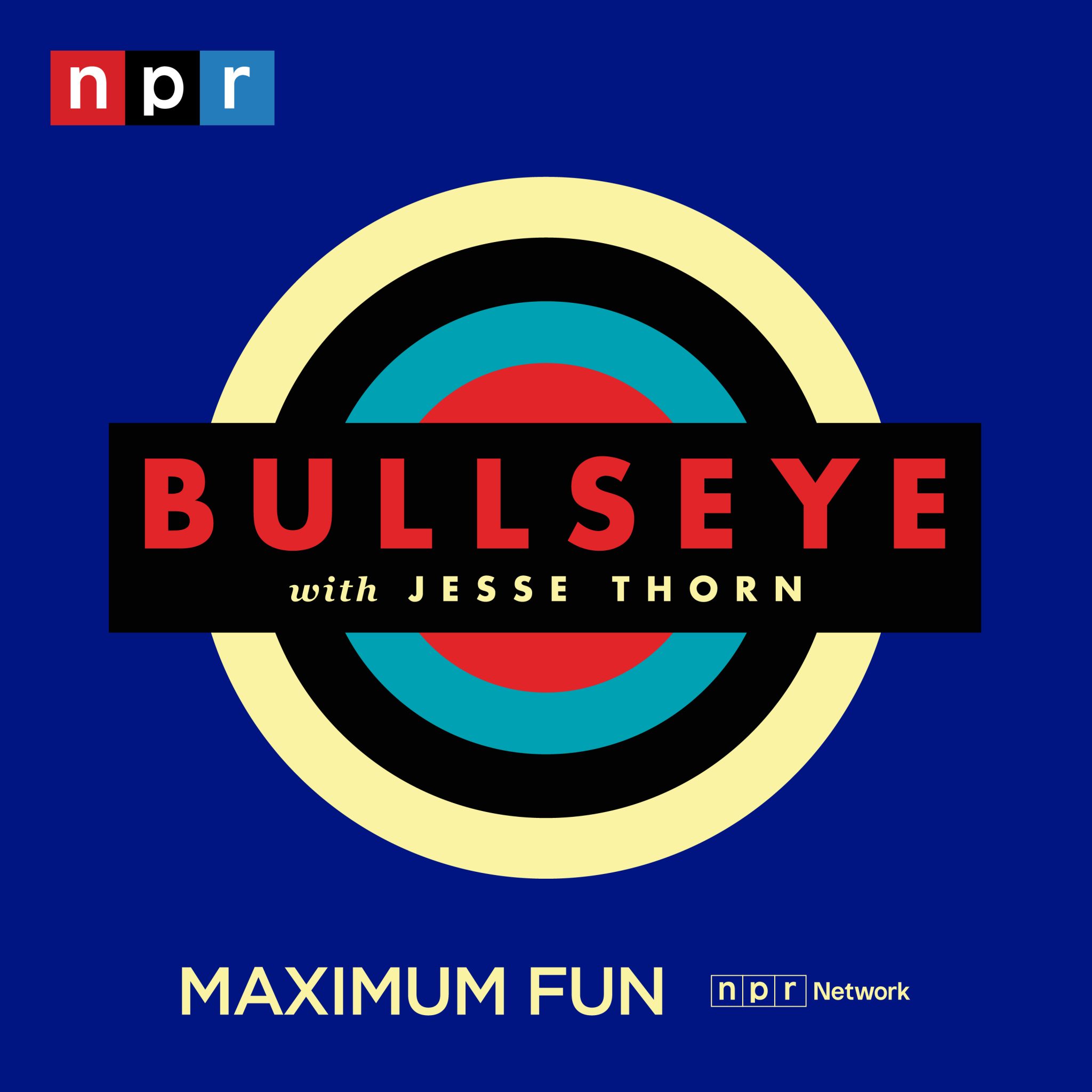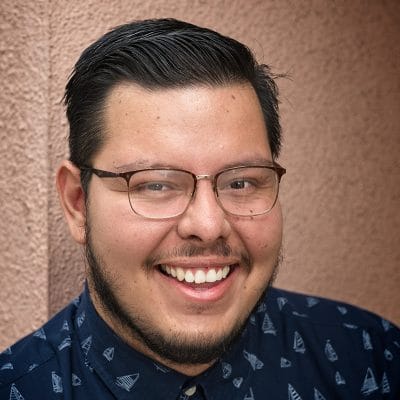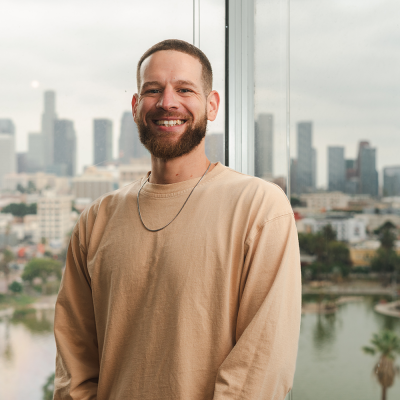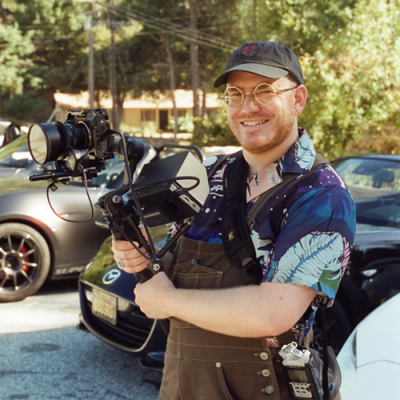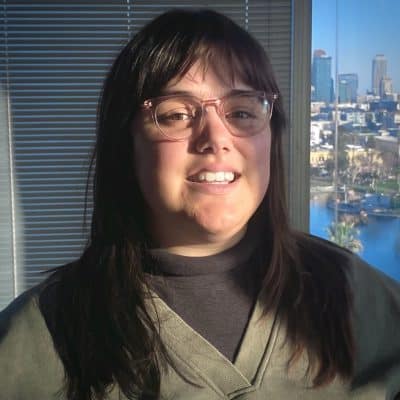Transcript
[00:00:00]
Transition: Gentle, trilling music with a steady drumbeat plays under the dialogue.
Promo: Bullseye with Jesse Thorn is a production of MaximumFun.org and is distributed by NPR.
Music: “Huddle Formation” from the album Thunder, Lightning, Strike by The Go! Team—a fast, upbeat, peppy song. Music plays as Jesse speaks, then fades out.
Jesse Thorn: It’s Bullseye. I’m Jesse Thorn. You can explain the magic of Wallace & Gromit—or maybe just part of it—in one scene. It comes from the first ever installment of that series. It’s called A Grand Day Out. Wallace is a goofy, bumbling, cheese-loving inventor living in provincial England. With his dog, Gromit, he builds a rocket to the moon, which is—as it turns out—made of cheese. So, the mission looks like it’s a success. They’re in the spaceship; they’re coasting toward the moon. And then Wallace realizes the fatal flaw in his plan.
Transition: A whooshing sound.
Clip:
Wallace (Wallace & Gromit): No crackers, Gromit!
(The sound of a bicycle bell being rung repeatedly.)
We’ve forgotten the crackers!
(A loud, dramatic musical stinger.)
Transition: A whooshing sound.
Jesse Thorn: On the page—or maybe in an audio medium like this—that line doesn’t inspire a big laugh. But if you’ve seen the clip, you know that Wallace holds his big, goofy hands on either side of his face, and—I guess sort of for emphasis—kind of frantically waves them left to right. That little gesture—I mean, for one thing, it is preposterous. Nobody actually does that with their hands. Not even like Liza Minnelli or whatever. But it also somehow communicates so much about how goofy, weird, and endearing the world of Wallace & Gromit is: the odd combination of the lowest possible and highest possible stakes.
The creator of Wallace & Gromit, who is my guest, Nick Park—he made that choice to have those waving hands. He, along with the famous stop motion production company at which he works—Aardman—have kept the Wallace & Gromit series going for more than 35 years.
There’s a new Wallace & Gromit story. It’s called Vengeance Most Foul. It’s a feature film. It just premiered on Netflix. It’s great. In it, Wallace invents a smart gnome named Norbot. Norbot. is mostly for gardening. He’s attracted attention from some of the locals, and Wallace even ends up doing an interview on the local TV news station. In this clip, Wallace & Gromit are watching that segment from home as it airs.
Transition: A whooshing sound.
Clip:
News Announcer: Good evening. Now, we’ve all heard of cutting-edge technology, but how about cutting-hedge technology?! (Giggles.) Anya Doorstep has more.
Music: Bright, airy orchestral backing music fades in.
Anya: Meet Norbot, the latest thing in gnome health. He’s the brainchild of a smart-thinking local inventor.
Wallace: Oh! Smart-thinking! Oh, thank you very much.
Anya: So, Wallace, what can Norbot do around the house?
Wallace: Oh, well, pretty much everything, Miss Doorstep.
Norbot: No job is too small! (Singing.) I’m a happy nifty Norbot. I like to trip the hedge! Ta-da! Artistic!
Transition: A whooshing sound.
Jesse Thorn: (Chuckling.) Nick Park, I’m so, so happy to have you on Bullseye. It’s really nice to meet you, and thanks for all your wonderful work.
Nick Park: Thanks, Jesse! It’s really lovely to be here.
Jesse Thorn: You do love a robot. I can tell. (Laughs.)
Nick Park: Yeah. Yeah. Always have done, actually. Yeah. They’ve always been in each of—in nearly all of the movies, really. Some mechanical things of some sort. Yeah.
Jesse Thorn: There’s something about like the semi-humanity of it that is—you know, that is not dissimilar to like why a monkey is funny. That it is lifelike, but is not alive. That sort of weird in-between-ness of it.
Nick Park: Yeah. Yeah. That’s pretty good. I’d go with that. Yeah. Yeah. There’s something about—even going back to my first film, my first Wallace & Gromit film, which was a student film: A Grand Day Out. There’s a robot cooker. Don’t ask me what that’s about. (Chuckles.)
And I think it’s the challenge of an inanimate object, really. I guess it’s what stop motion is about, of bringing something to life and how little you have to do to make something feel that it’s sentient.
[00:05:00]
You know, just very small gestures or observational kind of human gestures or—you know, that’s the, uh… I think that’s what stop motion is really good at, you know, and kind of brings out. Or can do, anyway. The humanity in otherwise inanimate things.
Jesse Thorn: I have to say, like I was thinking of Gromit, the dog from Wallace & Gromit, who not only doesn’t talk, but also doesn’t have a mouth. And his face is not even that dog-like. Like, it’s pretty simple and abstract. Like, it’s—you know. It might as well be like a balloon or something like that. And he just has those eyebrows. Like, it is the eyebrows and maybe a cock of the head that are the things that bring him to life.
Nick Park: Yeah, I mean, that’s very—yeah, I mean, it’s very observant. Thanks, yeah. I mean it. But I think you’re right, though. It is so simple. And I remember, on A Grand Day Out, you know, that student film, I was planning to actually have Gromit say something. You know, more like a Scooby Doo type of kind of human, semi-human kind of utterances, kind of mimicking his master. And I was actually planning to animate a mouth, but on the first day of shooting I just couldn’t get my fingers or—you know, it was just impossible to do it. And I just discovered that the brow could go up and down.
And in that moment, I discovered that, you know, I could give Gromit a much louder voice than if he had a mouth, even. And it was a strange kind of transition, really. A discovery, in a way, of something that was unplanned, but I suddenly had a dog that was much more sentient and intelligent than his master. And it made Wallace look a bit of an idiot, really. And a nice contrast of—a nice comedy kind of dynamic, really, that the dog was the smart one, and the human was the—well-meaning, but a well-meaning kind of idiot, really.
Jesse Thorn: I read this interview with, with Peter Lord, who co-founded Aardman Animation, and with whom you worked very extensively. And he was talking about first hiring you at Aardman and seeing some footage from A Grand Day Out, the first Wallace & Gromit film. And there’s a moment in there where, (chuckling) Wallace realizes they’re out of crackers and says, “We’re out of crackers.”
It is not a joke. There’s no punchline there at all. But Wallace brings his hands up; he says it, then brings his hands up in front of his face and wiggles his fingers. Like, his dumb, fat fingers, because he has very fat fingers.
(Nick laughs and agrees.)
In front of his face, like—(stammering) like he was creating—like he was in Wayne’s World when they go doodoo-doo-dooloop, doodoo-doo-dooloop. Like, that level of wiggling his fingers.
And Peter Lord said, that was so funny, without a joke, that they were like, “Oh god, we gotta get this guy. We gotta keep this guy around.”
Nick Park: (Laughs.) That’s funny. That’s funny, yeah. Was it the bit when he first did this? (Beat.) It might have been that. Yeah.
Jesse Thorn: Yeah, you’re showing me like palms up, hands closed, and that like, moving in and out, like an excited oughhhh!
Nick Park: Yeah, we now call that the Wallace wave. And it’s a—
(They laugh.)
It is. It’s like a kind of frustrated kind of panic. I remember that. I remember that happening. That was probably the first time that ever happened. And it was a kind of what to do in this situation, how to—(laughs). Yeah. You’ve got this clay figure with these, as you say, big fat fingers. And he suddenly—yeah. Realizes this. I think he says, (voice cracking) “We’ve forgotten the crackers!”
And I think it was just an actual thing that occurred to me on the day, really. Like, what do you do with— You know, I had the voice of PeterSalis saying the line, and I just kept saying it, and then thought—and that just came naturally, that waving his fist in and out like that. (Chuckles.)
[00:10:00]
It seemed very natural, and nothing I’d ever seen before by a human being, but it just worked. You know.
Transition: A whooshing sound.
Clip:
Music: A leisurely brass-band tune.
Wallace: Stilton!
(An ominous musical stinger.)
(Loud eating noises.)
Ohh, I don’t know, lad. It’s like no cheese I’ve ever tasted. Let’s try another spot.
Transition: A whooshing sound.
Jesse Thorn: Cheese is such a lovely thing for him to be obsessed with. Do you think that that— was that simply because—? You know, at least in my American conception, Northern England is factories and cheeses.
Nick Park: (Laughs.) That’s pretty good.
Jesse Thorn: I have a limited understanding, I will admit. But was his trip to the moon in that first story because he was motivated by cheese? Or was the cheese motivation because you wanted to send him to the moon?
Nick Park: (Laughs.) You know, I’m just trying to think. I did have a different story for that film, for A Grand Day Out, to begin with. And it was—I was trying to wrap the story up in a way that didn’t take me another— It’d taken me nearly seven years to make the film, and I didn’t want to spend another seven years. So, I had to curtail the story somewhat, and I had to find a reason. What was it? I don’t—which way around was it? Of why he would— ‘Cause I’d already decided to send them to the moon, and I needed to wrap the scene up in a way that made sense. And that, “We’ll go somewhere where there’s cheese.”
That’s right. And that was—yeah. That was the reason for the whole moon trip. Yeah. But it became—it was kind of an afterthought really. It felt a bit contrived, but yeah. (Laughs.) And everyone knows the moon’s made of cheese, so it made sense. Made story logic.
(They giggle.)
I was a student.
Jesse Thorn: So much more to get into with Nick Park. We’ll be back after a quick break. Stay with us. It’s Bullseye from MaximumFun.org and NPR.
Transition:
Jesse Thorn: I’m Jesse Thorn. You’re listening to Bullseye. I’m talking with Wallace & Gromit creator Nick Park. His latest project is the movie Wallace & Gromit: Vengeance Most Foul. It’s out now.
I saw a passing mention that while you were at Aardman in those early years, you worked on the Penny cartoons that ended up airing here as part of Pee-Wee’s Playhouse.
(Nick confirms.)
It’s like one of my favorite things ever, and I was so thrilled to think of your hand, you know, moving her hands as she, you know, brushes the sleep out of her eyes and opens up her eyes to those pennies.
Nick Park: Yeah, that’s right. We did do a spell in New York, working on the broadcast arts for Paul Reubens’, you know, Pee-Wee’s Playhouse. And we were asked to create this—you know, it was already designed on paper, but we were asked to interpret that into clay. And we produced 12 episodes for the first series, me and Richard Starzak.
Jesse Thorn: What did you learn from—like, those cartoons, like Creature Comforts, which has been your other sort of signature achievement, let’s say—you know, which won you your first Oscar in competition with Wallace & Gromit. Like, they’re both made from real audio, audio from interviews. Which was something that Aardman had done elsewhere.
(Nick confirms.)
What did you learn from talking to regular people and then making animation out of that?
Nick Park: It was—yeah, as you say, it was—I didn’t originate the idea of doing that. You know, Peter Lord and Dave Sproxton had done it previously, and I was kind of standing on their shoulders really. I think what I brought to it really was kind of—it wasn’t so much fly on the wall recordings that had been used before. I decided to go up to people and ask them about animals and zoos and see what they said. And it was animals this time rather than human beings.
[00:15:00]
So, that was my take on it.
Transition: A whooshing sound.
Clip:
Speaker (Creature Comforts): They try to make you comfortable. They try to put you in a quite nice situation, with standard food that look like—look more like a dog food than food proper for wild animals. Alright?
Transition: A whooshing sound.
Nick Park: What’s wonderful about it—and it so suits clay animation, this—I found is that— Because a lot of the voices, some were fantastic, but some when probably not that interesting or a bit kind of people just kind of waffling on if you like. But you can make it so interesting by giving it very small, like nuanced, human, little kind of observations. You know, you can have someone who’s not all that interesting. They can even be spending a lot of time—probably a bit like me now, where they’re kind of just talking aimlessly and thinking as they’re talking.
But just by animating their eyes, you know, glancing around space, you know, and then maybe just tapping the desk with their fingertips. And you know, I suddenly learned just how powerful that can be and how intriguing to an audience. And you can hold your audience for quite a long time, just doing these small things. And maybe play with what happens in all kind of documentaries or if you let the camera run. Something funny will happen eventually behind—you know, behind the character. Or something will fall over, or whatever it is.
So, it’s such a playground, you know, that you can— I always feel there’s still so much potential in that way of working.
Jesse Thorn: It seems like there’s something about—well, I mean obviously with the Creature Comforts film, there’s something about it being animals, right? We love the idea of animals behaving like people. And certainly the contrast between the very hyper realistic audio and the animation is something. There’s something about the way that animation can like focus your attention.
(Nick agrees.)
And that you can like—you can play with the scale of what you’re paying attention to, in a way that you can’t in any other medium. Right? You can just make it a little bigger or a little smaller in its impact.
Nick Park: Yes. Yeah, there’s a kind of purity to it, I found with that original Creature Comforts film in that there was— When I think of it, I spent seven years on A Grand Day Out. I spent three months filming Creature Comforts, which was five minutes, and that won the Oscar. Which was interesting.
But there’s like a purity, because there’s nothing to complicate it. You were just there with the characters. There was no camera moves, nothing too complicated in the actions. It was—you were just watching someone answer questions or, you know… you know, just keep waxing lyrical about whatever it was.
But you’re right. It is quite focused. And I often didn’t— You know, I edited the soundtrack first, you know, and chose the nice bits of juicy dialogue. But I didn’t always know what the animal was to start with or what it was going to do. So, sometimes I—
In fact, there’s the Brazilian jaguar who—well, he was the star of the show, really. At the very beginning, I was going to make him into a penguin, funnily enough. Strangely enough. I think it’s because I thought it’d be funny, because he kept saying, you know, “In Brazil, you’ll eat meat and potatoes! You know, lots of potatoes.” (Chuckling.) I thought a penguin saying that might be…
I mean, anything—any animal could have been funny, but I was glad I chose a jaguar for that, because it was so suitable. And ‘cause that was a, you know, a native animal of Brazil. And he was talking all about— I mean, I had met him before a few times. And I knew how much he hated living in the UK and the weather and the food and the lack of space. And he lived in a small flat in Bristol.
And so, I went to him and recorded him. And that was how—just asking people about what they think about zoos and animals, they tended to give the same response mostly of how it’s—you know, it’s not good to see the animals in cages, et cetera. But I wanted to know how they felt in their space.
[00:20:00]
Not about animals over there in the zoo. So, I did go to people who were, you know, in a situation that might be similar. You know, usually in a small house or a small flat. And that guy was so suitable as a candidate. And the way he kept repeating himself.
And then you just find things all the time. You just find things you can play off. Like, if a character keeps repeating something, you emphasize that in the animation, you know. Doing the same gesture every time, you know, “The space! We don’t have space! In Brazil, we have space. Over here, you don’t have space!”
(They chuckle.)
Jesse Thorn: I watched an animation that you made as a 13-year-old. And it was genuinely pretty good. I sincerely enjoyed—I mean, you know, it’s 10 seconds long or 15 seconds long. But it’s like a Jack & the Beanstalk where the punchline is that it gets to the top, and the giant just slips and falls. And I wondered like did you always have the patience to animate by yourself? Were you always able to overcome the frustration that comes from working for hours and having a second or two seconds of footage?
Nick Park: Well, I’m not sure if I always did have patience, really. (Chuckles.) I know that’s the commonest thing people say is that how much you must need patience. Which is, I think, very true of many animators. I think it’s partly why I never really got into intricate animation. You know, like very fine animation. In a way, it stopped me from, you know, overindulging in that sense, in that my lack of patience maybe made me go for more simple types of animation.
So, I always was attracted to types of animation that are quicker to do and a bit more—where you can improvise more as you go. One of my—the film that got me into film school actually was—I spent a couple of years on a puppet film that didn’t do very well; it wasn’t that interesting. And then I just made this film with using chalk on blackboard, you know, on chalk board. You know, where you rub out each image, draw another one, and that kind of thing. And that had a lot more kind of freshness and humor to it.
And yeah, I do believe that got me into film school. It got more noticed, because it was just kind of a bit bizarre and wacky humor, really I suppose.
Jesse Thorn: A lot of clay animation is shot very simply. Like, a locked camera on a set, and the characters move through that set. Wallace & Gromit has always been intensely filmic. Like, to the extent that—like, the films are often like almost as much about the way that they are shot and look as they are about anything else. Like, there’s a noir film. (Chuckles.) Like, this one is very much an action film, like it really reminds me of—you know, there’s a lot that reminds me of Mission Impossible. (Chuckles.) The most recent Mission Impossible movie.
Nick Park: (Chuckling.) That’s interesting.
Jesse Thorn: Was that always an important part of what you wanted to do? That you wanted to not be limited by a static camera?
Nick Park: Yeah. And I think it’s the—for me, what the attraction of puppets, if you like to call them or, you know, clay figures—you know, the fact that it’s the real 3D animation. (Chuckles.) CG now is called 3D, but this is actual 3D. And it’s the attraction of it. It’s always been the attraction, the fact that you have a figure—it may be only nine inches high, but you can use the camera, you can use the camera from different angles, the lighting.
I think the magic for me was all the stuff I saw on TV, which was very—as a kid, it was very much like on a stage where the camera was at one side. So, it was all shot like a soap sort of thing, where the camera couldn’t look the other way, because it was obviously a studio. And I like to kind of break that and have the—you know, you shoot all your shots one way, and then you build another bit of set, and you shoot the other way, so that you feel like you’re completely immersed. You know, as in any movie, that you’re actually in the set and in the world.
[00:25:00]
And it’s dimensional and real. That’s always been the attraction of it. And so, it naturally—like you say, I think there’s always been a… growing up loving movies and, going to film art school and film school, and just talking movies all the time. I was always very inspired to push the medium into the more movie realm. You know, camera moves do that a lot.
And definitely today—I remember in The Wrong Trousers—(chuckles) the movie, where Feathers McGraw, the character who’s returned in this film—you know, he’s just this small penguin, about four inches high. Quite simple, like a wine bottle, really. And I remember just realizing the power that you even though he hardly moves—he maybe blinks a little bit—but with a camera move and with Julian Nott’s music and putting a little sting on the camera move, he suddenly has like a screen presence.
And the audience interprets, you know, what he’s thinking. You know, they understand that the cogs are turning just by a blink or two. And in a way, that for me is like the power of cinema. You know, that the audience do a lot of the work actually, and you do very little. (Laughs.) But it’s about what little you do do, I guess, is what’s important.
Jesse Thorn: We’re gonna take a quick break. Soon we will wrap up my conversation with Wallace & Gromit creator Nick Park, and I will ask him one very important question. Has he met any real-life dogs named Gromit? And how many of those dogs were good boys? It’s a little something called journalism, folks. I think this is going to get us the Peabody. It’s Bullseye for MaximumFun.org and NPR.
Promo:
Music: Playful, upbeat music.
(A phone rings.)
Hannah: Hello?
Clint McElroy: Hannah?
Hannah: Yeah!
Clint: It’s Clint McElroy! Hi Hannah!
Hannah: Oh my god, hello!
Clint: I don’t know if you know who I am.
Hannah: Oh, I do. I love The Adventure Zone. It is probably my favorite D&D podcast.
Clint: You’ve been a faithful member of Maximum Fun since March of 2019. And this is them rewarding you as our Maximum Fun Member of the Month.
Hannah: It’s awesome. I love it!
Clint: So, what made you decide to become a member of MaxFun?
Hannah: You know, it was so long ago, I’m not sure what the exact moment where I decided was. I think I’ve kept it up intentionally, because a lot of those different podcasts have been there for me when I felt really alone and sad and just needed something to laugh at. (Chuckles.)
Clint: Aww, well, that’s—Hannah, thank you so much. Thanks for being a member. Thanks for being a TAZ fan. Thanks for all the nice things you had to say about me, specifically, and I guess my kids. I guess. Indirectly.
Speaker: If you’re a MaxFun member, you can become the next MaxFun member of the month. Support us at MaximumFun.org/join.
(Music ends.)
Transition: Thumpy synth with light vocalizations.
Jesse Thorn: It’s Bullseye. I’m Jesse Thorn. My guest is Nick Park. He’s the creator of the stop motion series Wallace & Gromit.
There was a time when you had to make everything in your films by hand. And for the most part, everything was made out of plasticine, which is like the kind of sculpting clay—nondrying, non-hardening sculpting clay that like kids would use at daycare or something. Over time, there have been a lot of advancements both in materials—in that you could use, you know, certain kinds of flexible silicone or whatever—but also in technology, in that you can animate things in Claymation film with computers.
So, how do you decide when you’re making the most recent film, what is made out of clay and has a fingerprint on it, and what comes out of a computer, and what comes out of a—I don’t know—a 3D printer or whatever the silicone comes out of.
Nick Park: Yeah. Mm-hm. Yeah, well, I think fundamentally, it’s clay. You know, it’s important to me and I know to Merlin, who directed with me on this, that—we’re great believers that it’s the authenticity and the sculpting that’s really at the heart of it all.
[00:30:00]
And that everything is made by hand and by people. And yeah, it’s very much part of the very ethos of a Wallace & Gromit film. And that’s the sets and everything. But there does come a point amongst our crew and the art department and the people building the puppets and the animators as to how long the puppet lasts and how practical things are.
And sometimes, especially if a character isn’t close up—if they’re walking across, we might shift to a silicone puppet. But you know, still with the same steel armature inside. And the original one would’ve been made of clay and cast and molded. And then—so, he still has—the silicone still picks up the fingerprints and looks like clay.
But you know, the puppets, they suffer a lot of wear and tear in a shot. So. And it can take up a lot of time, so sometimes it’s an economic thing to do some of the shots using silicone puppets. But where the puppets really have to express, we stay with clay a lot of the time.
Jesse Thorn: Do you still have to like wear gloves or wash your hands constantly in order to keep the light-colored clay from getting dingy looking?
Nick Park: Yeah, the animators do have to. We’ve often had like a tub of those baby wipes next to us, where— Because you can, you know, be handling—say—Wallace’s trousers, and if they’re made of clay, you’re getting brown clay on your fingers. And then if you touch, you know, the white sleeves, you’ll get all sorts of, you know, messy colors mixing and stuff. So, the animators have to clean their hands a lot between handling the different colors. But with silicone, that’s less of a problem as well.
Jesse Thorn: Do you find the world of Wallace & Gromit comforting?
Nick Park: Yeah! Yeah, I do. I do. (Giggles.) That’s—I’ve never been asked that before! I do. It’s… (laughs). I think that’s what’s so attractive to me about it. It’s so familiar, you know.
And a lot of it comes from childhood. You know, I often—from coming up with the set, the first drawings and the first designs, I tended to draw from my childhood and the things I knew. You know, the carpets, the wallpapers of my granny’s house and, you know, the standard lamp from my granny’s house, the tray that Wallace picks up the cheese and the cups of tea in A Grand Day Out. You know, we had that tray when I was a kid. So, a lot of it is memories, and it’s all kind of expanded from there, really.
And it’s in a sort of timeless age, you know, when I—probably, I was about eight or something like that. And you know, we could never afford fashionable items in the house. It was all throwback from the 1950s. In the ‘60s, we had stuff from the ‘50s. So, you know. (Chuckles.) And so, nothing matched, you know. But it was a time when everything had character as well, not to be too kind of nostalgic. But it was—whereas—
We tend to keep Wallace & Gromit in a kind of time somewhere between the ‘50s and present day, but not too present. Although we have to stretch that a bit in this one. We have stretched this a little bit. Because for the first time, Wallace & Gromit need computers in this one, because Wallace invents a smart gnome. So, that might have been a bit too much of a leap from ‘50s technology. So, so we’re slightly updated. But.
Jesse Thorn: Like, yeah, even the computer that you’ve invented, it’s like if a—like, it has a monitor, but otherwise it’s basically like a Univac. (Laughs.)
Nick Park: Yeah, yeah. It’s like a ‘80s computer. You know, we’ve kind of pushed it to the 1980s when computers now look quite antique. And put rivets on it, so it looks like Wallace has made it.
Jesse Thorn: Is it different to visit this world as a man in now like late middle age than it was when you were 24?
Nick Park: I guess it was all novel then, you know. It was… and it was kind of nice. Yeah, I mean, it still is nice, actually, to—
[00:35:00]
A lot of it was the fact that you could do it, and you could make them—you know, I made a lot of the models myself as a student and early on, and then… But it’s the beauty of being able to make stuff and film it, and it’s real. (Chuckles.) And designing stuff is a pleasure, you know. Little sideboards and street corners and things like that. Um. I don’t know where I’m going with that. (Laughs.) But yeah.
The novelty’s never worn off. It’s just we have bigger teams making stuff now, and an art department. You know, so we can go more to town on things.
But that’s what kind of inspired, you know, all the puns and all the little written jokes in places. Because you’re making these models, and you think, “Ah, there’s comic potential in this. What—? You know, is it a Hoover, or do we make up another name?” You know what I mean? We can play on words all the time.
I think the first time was—oh, I think it was in A Grand Day Out again. There was a sled in the background and just leaning up against the wall and just decided to call it Rosebud. But it’s like if you spotted it, sort of thing, so if you’re a film buff you’d know what that was.
Jesse Thorn: I remember a refrigerator that said Smug on it instead of Smeg. It was that kind of like fancy faux retro.
Nick Park: (Laughing.) Yes! Yeah. Yeah, we have such a great time playing with all that stuff. The storyboard artists, the art department, they come up with lists of stuff. Of course, we’ve got to be very careful, so everything gets checked by legal these days as well. Once upon a time, it wasn’t so strict. In fact, with Smeg and Smug, they—I don’t think we had permission, but they loved it. (Chuckles.)
Jesse Thorn: I mean, what’s great about it is, you know, unlike a sign in the back of The Simpsons or something—which is—you know, those are some of the most perfect jokes that have ever been created, a sign in the back of The Simpsons, right?
Nick Park: Yeah, absolutely.
Jesse Thorn: They are never anything other—in the Wallace & Gromit films—than just a little, gentle punch in the shoulder. (Laughs.) Like, a little like “Wouldn’t it be fun if we?”
Nick Park: Yeah. Yeah, I think that’s it, really. There’s a kind of a soft—there’s a softness to it. I mean, it can be a little bit, uh—not controversial, but there can be little digs at things, but they’re soft. Yeah. Yeah. Background.
Jesse Thorn: Have you met dogs named Gromit?
Nick Park: (Laughs.) Met them? I’ve heard of people— Somebody told me they were in the park once and heard someone shouting, “Gromit! Gromit” to their dog.
(They chuckle.)
Jesse Thorn: Never even at a signing? Nobody comes up to you and says, like the Pope, “Will you bless my dog?”
Nick Park: (Laughs.) Not quite. No, I’ve never had that. That’s never happened. No.
Jesse Thorn: Autograph my dog?
Nick Park: (Laughs.) People have shown me photographs of—you know, sometimes it’s Wallace and Gromit, the dogs—or cats, or goldfish, whatever.
Jesse Thorn: Well, Nick, I have to tell you—I was like looking at a timeline when I was preparing for this interview. And A Grand Day Out was released in 1989, and I saw it at a Spike and Mike festival of animation in San Francisco with my mom.
Nick Park: Right, really? Gosh.
Jesse Thorn: You know, at Spike and Mike, there were these big omnibuses of different stuff, and a lot of the stuff was four minutes long or three minutes long, because it’s so much work to make animation. And so, you’d show up, and I’d be at the Roxy Theater in San Francisco and the Mission, or at the Palace of Fine Arts later on in San Franciso. A big theater.
Nick Park: Yeah, I remember that.
Jesse Thorn: And they would hand you a little playbill that had a list of everything that you were gonna see. And you never knew what it was gonna be until you got there and got handed that playbill, because all you saw was Spike and Mike’s Festival of Animation. And I remember vividly the excitement of seeing that I was gonna get to see a new Wallace & Gromit thing.
Nick Park: Wow!
[00:40:00]
Jesse Thorn: And I mean, I just wanted to thank you for it. Like, before we talked, I was saying—I’m going to the airport in 40 minutes to pick up my mom. It’s going to be her 80th birthday. And it’s such a special and treasured thing for me that I got to share that with her. I mean, also Bambi vs. Godzilla and everything. (Laughs.)
Nick Park: Yeah, I remember that, yes. Yeah, yeah! Marv Newland. Yeah, yeah. Yeah.
Jesse Thorn: But I just wanted to say thank you for that really beautiful work.
Nick Park: Oh, thank you. Gosh, that means a lot. I really appreciate that.
Jesse Thorn: And I had the same excitement to get to watch the new one, which was absolutely every bit as wonderful as all of the films that you’ve made in this series. It’s really a special achievement. So, thanks.
Nick Park: Wow, thank you. That’s very kind. I remember those days at Spike and Mike’s Festival as well. That was my first—I went there with Creature Comforts and A Grand Day Out, I remember. And that was the first time I ever signed an autograph for anyone.
(Jesse chuckles.)
La Jolla in San Diego. Yeah.
Jesse Thorn: Well, Nick Park, thank you so much for coming in. Thank you so much for making the time, and thanks for this great movie. And it’s just a hoot and a half. I had to watch it by myself for logistical reasons, but I’m excited to share it with my family.
Nick Park: Oh, great. Thank you so much. It’s been so nice chatting. Thanks, Jesse.
Jesse Thorn: Nick Park. As we mentioned, Wallace & Gromit: Vengeance Most Foul, is streaming on Netflix. And let me tell ya, it is a great time.
Transition: Energetic, upbeat synth with light vocalizations.
Jesse Thorn: That’s the end of another episode of Bullseye. Bullseye is created from the homes of me and the staff of Maximum Fun, as well as at Maximum Fun HQ overlooking beautiful MacArthur Park in Los Angeles, California.
(Music fades out.)
As we record this, much of our hometown of Los Angeles is either burned or on fire. It is really upsetting and terrifying. And overwhelming, frankly. If you’re in Southern California, I hope that you will join us in working on mutual aid projects—whether that is hosting a friend, handing out some masks, or just giving some no strings attached money to a friend who has lost something. If you are not in Southern California, we have been hearing a lot of requests about “What can I do? Who should I send some money to?”
One great way to support the folks who are suffering and support the recovery efforts is through the California Community Foundation, who have a wildfire recovery fund. California Community Foundation is an incredible resource here. They fund a lot of local community foundations as well. That fund, that wildfire recovery fund, covers both immediate disaster needs and also longer-term recovery efforts on a local basis. That’s California Community Foundation, very highly rated charity. They do a lot of great work. You can find a link to that fund on their website, which is CalFund.org. That’s CalFund.org. Of course, one of many, many ways to help. But if you need one, that’s a good one.
(Music fades back in.)
Our show is produced by speaking into microphones. Our senior producer is Kevin Ferguson. Our producers are Jesus Ambrosio and Richard Robey. Our production fellow at Maximum Fun is Daniel Huecias. Our video producer is Daniel Speer. Special thanks this week to the crew at Nine Tree Studios in Bristol, the United Kingdom, for recording our interview with Nick Park. We get booking help on the show from Mara Davis. Our interstitial music comes from our friend Dan Wally, also known as DJW. You can find his music at DJWSounds.bandcamp.com. Our theme music was written and recorded by The Go! Team. It’s called “Huddle Formation”. Thanks to The Go! Team. And thanks to their label, Memphis Industries.
You can follow Bullseye on Instagram, TikTok, and YouTube—where you will find video from just about all of our interviews, including the ones that you heard this week. Seriously, go out there, subscribe to us on—if you’re on TikTok, subscribe. Follow on TikTok. If you’re on Instagram, follow us on Instagram. And if you’re on YouTube, follow us on YouTube. Smash those like and subscribe buttons. You know how it is. I mean, even if you’re only a podcast listener, go hit subscribe. Pick out some interview that you really liked, and send it to a friend who might enjoy it. Please?
Okay. I think that’s about it. Just remember, all great radio hosts have a signature signoff.
Promo: Bullseye with Jesse Thorn is a production of MaximumFun.org and is distributed by NPR.
(Music fades out.)
About the show
Bullseye is a celebration of the best of arts and culture in public radio form. Host Jesse Thorn sifts the wheat from the chaff to bring you in-depth interviews with the most revered and revolutionary minds in our culture.
Bullseye has been featured in Time, The New York Times, GQ and McSweeney’s, which called it “the kind of show people listen to in a more perfect world.” Since April 2013, the show has been distributed by NPR.
If you would like to pitch a guest for Bullseye, please CLICK HERE. You can also follow Bullseye on Twitter, YouTube, and Facebook. For more about Bullseye and to see a list of stations that carry it, please click here.
Get in touch with the show
People
How to listen
Stream or download episodes directly from our website, or listen via your favorite podcatcher!
